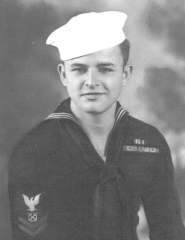Charles F. Wernette

Charles F. Wernette
CHARLES
F.
WERNETTE
SOLDIER DETAILS
BIOGRAPHY
I enlisted in the US Navy for a six-year hitch. I had two older brothers in the service; John was in the Navy submarine service and Eugene was in the Air Corp. My father was the Commander of the Civil Air Patrol during W.W. II in Clay Center, Kansas, and my mother was also a member of the C.A.P. After my boot camp training at the Great Lakes Training Center, I shipped out on the U.S.S. Antares for Pearl Harbor to catch the ship that I would call home for the next 4 � year, the U.S. S. Wright, a seaplane tender. I was assigned the 2nd division aboard the ship, which was a deck division. My General Quarters station was powder man on the five-inch, 51-foot gun. The main responsibility of our ship was to anchor at one of the islands: Johnson, Wake, Midway, Palmspree and Christmas as well as others. Seaplanes would fly in and anchor by our ship and fly out again in the morning a search planes. After their missions were completed, they would fly back to Pearl Harbor and our ship would follow. Our last trip to Wake Island, we transported several Marines; all were either killed in action or captured and spent the rest of the war as P.O.W.'s in Japan doing forced labor. We left Wake Island November 30, 1941 for our return trip to Pearl Harbor. Arriving in Pearl Harbor on December 6, 1942, we found the submarine nets were already in place at the Harbor entrance, so no ships were allowed to enter or exit. That night, we ended up having to anchor outside the Harbor. The next day, December 7, 1941, the Japanese attacked and since our ship was not in the Harbor area, we were not hit. It was a very sad sight to see the devastation and destruction of the great and beautiful ships being damaged and sunk. It was horrible, what was happening to those men and women and a horrific and sickening feeling that I'll never forget. One of the Marines that we had just taken over to Pearl on our last trip was a boy from my home town. We had several good visits aboard the U.S. S. Wright and in Honolulu before I left the island. He ended up being wounded and captured after a 16-day defense of the island. After the war, this young man came home and ended up marrying one of my sisters (who had lost her first husband, an air force pilot earlier in the war.) Eventually, an order came through that stated anyone with 30 months overseas was due to return to the United States. It actually took me two weeks to get to Marc Island, California, as we had to find our own way back home. After my discharge, I came home to Clay Center, Kansas and married Vera LaRue Gibbs in 1949. We had five children and have been blessed with several grand and great grandchildren.
 Eisenhower Foundation
Eisenhower Foundation
